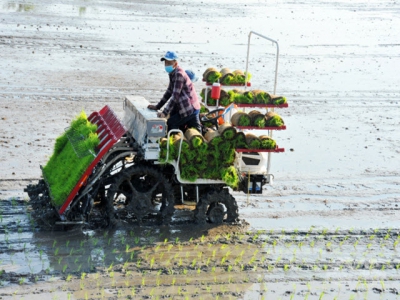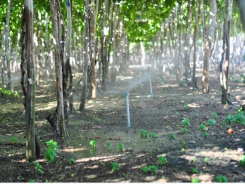Ensuring a successful autumn-winter crop

An Giang establishes plans for autumn-winter sowing on land surrounded by dikes in order to guarantee a 100% success rate during the upcoming flooding season.
An Giang sowed 160,000 hectares in the dike-protected area to manage flood this autumn-winter crop. Photo: Le Hoang Vu.
100% land encircled by dikes
According to Mr. Nguyen Si Lam, Director of An Giang Department of Agriculture and Rural Development, the province is the first of its kind along the Mekong river, which is always prone to flooding throughout the autumn-winter crop production season.
As a consequence, to guarantee the success of this year's crop production, the province advises farmers to plant inside the boundary of 699 subregions surrounded by embarkments to fully manage flooding throughout the province's 160,000 hectares. The province has currently sown more than 83 percent of this area and intends to achieve a yield of 6.2 tons of rice per hectare and an output of about 1 million tons.
The schedule for autumn-winter crop sowing is determined by the Department of Crop Production's cropping schedule for the Mekong Delta region, as well as the meteorological and hydrological conditions, the time of sowing according to each sub-region of the previous crop, and the development of brown planthoppers in the region.
Farmers are urged to concentrate on the proper use of affordable irrigation solutions, to encourage the use of ecological technologies, and to grow flowers along the fields' banks so as to attract natural enemies to pests and reduce pesticide usage during the first forty days after the seeds have been sown. The provincial agriculture sector will increase communication, strengthen production promotion, and instruct farmers about pesticide usage in accordance with the "four rights" principle.
An Giang's agricultural sector is also strengthening technical measures to improve rice plant health, such as using micronutrient supplements and fertilizers containing calcium and silicon, to assist rice plants in increasing their natural resistance; conducting regular field inspections to detect pests early; guiding farmers in pest management, and taking timely response measures to protect rice yield.
This year the province is encouraging high-quality rice production for the autumn-winter harvest, with 85 percent of the land planted with high-quality rice varieties such as OM 9582 and OM 5451, as well as avoiding cultivation of MARD-unrecognized rice varieties
Regarding consumption and association with rice production businesses, Nguyen Sy Lam, head of An Giang's agricultural sector, stated that the complex developments of the Covid-19 pandemic have affected the production and consumption of certain agricultural products in the area. However, An Giang's summer-autumn rice crop of 2021 has a total area of 64,825 hectares for rice production and consumption, representing 28% of the entire sowing area, with 27 businesses and enterprises participating in the production link chain.
In the 2021 autumn-winter harvest, An Giang's agriculture sector will create ideal circumstances and maintain connection with aforementioned businesses in order to help farmers with the most convenient rice consumption conditions.
Over 70,000 hectares of flood discharge to providealluvium
An Giang intends to discharge floodwaters for about 70,000 hectares of agricultural production land this autumn-winter rice crop in order to collect alluvium, as well as clean the fields, provide fresh water, and serve the local population.
Flood discharge will occur once in the Long Xuyen quadrangle and downstream regions in the form of "eight harvests in three years". However, it is predicted that the flood will occur later this year than in previous years, and the water level will remain the same as last year.
The annual growth of three-crop production areas has resulted in an increase in cultivated area, increased land rotation, increased revenue, and increased land value.
However, as a result of continuous production for many years, many areas do not arrange flood discharges according to the agreed "eight harvests in three years" rule, and therefore certain sub-regions produce three rice crops. Sowing is currently behind the seasonal timetable, as recommended by the professional agricultural sector.
Since then, extended cropping has harmed rice production by providing ideal circumstances for the development of dangerous organisms, making them harder to manage, degrading soil, increasing the quantity of fertilizer needed, raising production costs, and reducing rice yields.
Because herbicides and pesticides are not washed away, the soil becomes polluted, resulting in hazardous rice quality. As a result, it is critical to creating a flood discharge strategy, even more so in light of the present paradigm, which encourages people to produce rice in a clean, safe, and sustainable manner.
"Before releasing the flood, the district will inform the public at the start of the year and continually for one month prior to releasing the flood. The pumping station system in the flood discharge region must be fully maintained and operated properly in order to regulate water while discharging floodwaters, defining the time and water level to be maintained in the flood discharge area.
Whatsmore the district will monitor the area of vegetables and fruit trees with hazardous banks produced before the plan's implementation. Households who rear cattle, produce vegetables, and fruit trees must invest in embankments to safeguard their productive areas from flooding.”
Ms. Nguyen Thi Ngoc Lan - Vice Chairman of the Chau Phu District People's Committee, An Giang province
Có thể bạn quan tâm
Phần mềm

Phối trộn thức ăn chăn nuôi

Pha dung dịch thủy canh

Định mức cho tôm ăn

Phối trộn phân bón NPK

Xác định tỷ lệ tôm sống

Chuyển đổi đơn vị phân bón

Xác định công suất sục khí

Chuyển đổi đơn vị tôm

Tính diện tích nhà kính

Tính thể tích ao hồ



 Dragon fruit with planting area code conquers the…
Dragon fruit with planting area code conquers the…  Avoiding breaking the chain of agricultural production, processing…
Avoiding breaking the chain of agricultural production, processing…